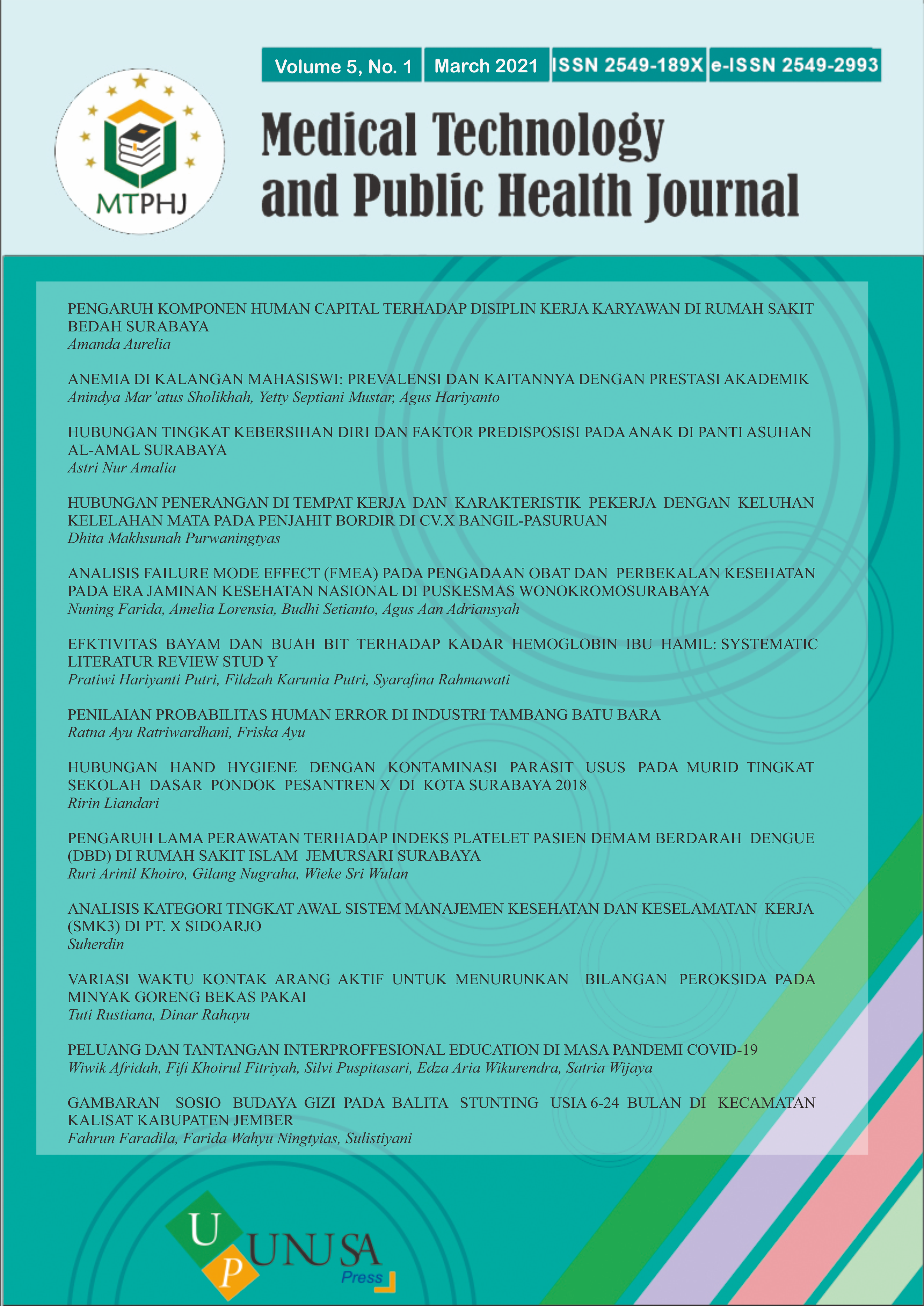ANEMIA DI KALANGAN MAHASISWI: PREVALENSI DAN KAITANNYA DENGAN PRESTASI AKADEMIK
Main Article Content
Abstract
Anemia is still considered as a serious health problem worldwide that requires large attention. Anemia does not only have an impact on health but also affect student achievement. This study aims to identify the prevalence of anemia among female university students in Surabaya and its relationship to academic achievement. This is an observational analytic study with cross-sectional design, involving 92 respondents who were selected using a consecutive sampling method. Data collected by using a questionnaire to obtain respondent characteristics, grade point average (GPA), and menstrual patterns. The measurement of hemoglobin levels carried out using the cyanmethemoglobin method. The results showed that the prevalence of anemia among female students was still quite high and there was a significant relationship between the incidence of anemia and students’ academic achievement measured by grade point average. Female students are one of the groups that are susceptible to anemia, so it is essential to make various efforts to improve Hb levels by increasing the intake of foods high in iron.
Downloads
Article Details
Copyright (c) 2021 Medical Technology and Public Health Journal

This work is licensed under a Creative Commons Attribution-ShareAlike 4.0 International License.
References
Lestari IP, Lipoeto NI, Almurdi A. Hubungan konsumsi zat besi dengan kejadian anemia pada murid SMP Negeri 27 Padang. J Kesehat Andalas. 2018;6(3):507.
Al-Jamea L, Woodman A, Elnagi EA, Al-Amri SS, Al-Zahrani AA, Al-Shammari NH, et al. Prevalence of iron-deficiency anemia and its associated risk factors in female undergraduate students at prince sultan military college of health sciences. J Appl Hematol. 2019;10(4):126–33.
Wahyuni I. Hubungan kepatuhan konsumsi tablet Fe dengan kejadian anemia pada ibu post partum di wilayah kerja Puskesmas Payung Sekaki Pekanbaru. Med Usada [Internet]. 2019;2(2):32–9. Available from: http://ejournal.stikesadvaita.ac.id/index.php/MedikaUsada/article/view/53
McClung JP, Marchitelli LJ, Friedl KE, Young AJ. Prevalence of iron deficiency and iron deficiency anemia among three populations of female military personnel in the US Army. J Am Coll Nutr. 2006;25(1):64–9.
Ramzi M, Haghpanah S, Malekmakan L, Cohan N, Baseri A, Alamdari A, et al. Anemia and Iron Deficiency in Adolescent School Girls in Kavar Urban Area, Southern Iran. Iran Red Crescent Med J. 2011;13(2):128–33.
Al-Alimi AA, Bashanfer S, Morish MA. Prevalence of iron deficiency anemia among university students in Hodeida province, Yemen. Anemia. 2018;2018.
Khaskheli MN, Baloch S, Sheeba A, Baloch S, Khaskheli FK. Iron deficiency anaemia is still a major killer of pregnant women. Pakistan J Med Sci. 2016;32(3):630–4.
Shill KB, Karmakar P, Kibria MG, Das A, Rahman MA, Hossain MS, et al. Prevalence of iron-deficiency anaemia among university students in Noakhali Region, Bangladesh. J Heal Popul Nutr. 2014;32(1):103–10.
Al-Zabedi EM. Prevalence and risk factors of iron deficiency anemia among children in Yemen. Am J Heal Res. 2014;2(5):319.
Al Hassan NN. The prevalence of iron deficiency anemia in a Saudi University female students. J Microsc Ultrastruct. 2015;3(1):25–8.
Dumilah PRA, Sumarmi S. Hubungan anemia dengan prestasi belajar siswi di SMP unggulan bina insani. Amerta Nutr. 2017;1(4):331.
Hidayat N, Sunarti S. Validitas pemeriksaan kadar hemoglobin menggunakan metode Hb meter pada remaja putri di MAN wonosari. Kesmas. 2015;9(1):11–8.
Irsa L. Gangguan kognitif pada anemia defisiensi besi. Sari Pediatr. 2002;4(3):114–8.
Insel P, Turner RE, Ross D. Discovering Nutrition. 3rd Editio. Caanada; 2010.
Balitbangkes. Riset Kesehatan Dasar 2013. Jakarta; 2013.
Setyono FS. Hubungan tingkat pengetahuan gizi, body image, dan tindakan diet dengan status anemia dan status gizi remaja putri. Universitas Airlangga; 2010.
Permatasari T, Briawan D, Madanijah S. Efektivitas program suplementasi zat besi pada remaja putri di kota Bogor. J MKMI. 2018;14(1).
Kemenkes. Pesan Untuk Remaja Putri Indonesia: Cantik itu Sehat, Bukan Kurus [Internet]. 2018 [cited 2021 Jan 21]. Available from: https://www.kemkes.go.id/article/view/18112300003/pesan-untuk-remaja-putri-indonesia-cantik-itu-sehat-bukan-kurus.html
Hamali HA, Mobarki AA, Saboor M, Alfeel A, Madkhali AM, Akhter MS, et al. Prevalence of anemia among Jazan university students. Int J Gen Med. 2020;13:765–70.
Sumarlan ES, Windiastuti E, Gunardi H. Iron status, prevalence and risk factors of iron deficiency anemia among 12- to 15-year-old adolescent girls from different socioeconomic status in indonesia. Makara J Heal Res. 2018;22(1):46–52.
WHO. Iron deficiency anemia: assessment, prevention, and control-a guide for programme managers. Geneva; 2001.
Li L, Huang L, Shi Y, Luo R, Yang M, Rozelle S. Anemia and student’s educational performance in rural Central China: Prevalence, correlates and impacts. China Econ Rev [Internet]. 2018;51(620):283–93. Available from: http://dx.doi.org/10.1016/j.chieco.2017.07.006
Sylvia S, Luo RF, Yue A, Shi YJ, Zhang IH, Martorell R, et al. Anemia and cognition: Are our diagnoses wrong? REAP Work Pap. 2016;Standford,.
Farida RN. Gambaran dan determinan anemia pada mahasiswi S-1 reguler fakultas kesehatan masyarakat universitas indonesia tahun 2012. Universitas Indonesia; 2012.
Leginem. Faktor-faktor yang berhubungan dengan status anemia mahasiswi akademi kebidanan di Kota Banda Aceh tahun 2002. Universitas Indonesia; 2002.
Rusman ADP. Pola makan dengan kejadian anemia pada mahasiswi yang tinggal di kos-kosan. J Ilm Mns dan Kesehat. 2018;1(2):144–51.
Simanungkalit SF, Simarmata OS. Pengetahuan dan perilaku konsumsi remaja putri yang berhubungan dengan status anemia. Bul Penelit Kesehat. 2019;47(3):175–82.
Arisman MB. Gizi dalam daur kehidupan. Edisi 2. Jakarta: Penerbit Buku Kedokteran EGC; 2010.
Hogan AM, Pit-ten Cate IM, Vargha-Khadem M, Prengler M, Kirkham FJ. Physiological correlates of intellectual function in children with sickle cell disease: hypoxaemia, hyperaemia and brain infarction. Dev Sci. 2006;9(4):379–87.
Dowling MM, Quinn CT, Rogers ZR, Buchanan GR. Acute silent cerebral infarction in children with sickle cell anemia. Pediatr Blood Cancer. 2010;54(3):461–4.
Cordeira LS, Wilde PE, Semu H, Levinson FJ. Household food security is inversely associated with undernutrition among adolescents from Kilosa, Tanzania. J Nutr. 2012;142(9):1741–7.
Teni M, Shiferaw S, Asefa F. Anemia and its relationship with academic performance among adolescent school girls in kebena district, southwest Ethiopia. Biotechnol Heal Sci. 2017;4(1):1–8.
Miller G, Luo RF, Zhang LX, Slyvia S, Shi YJ, Foo P, et al. Effectiveness of provider incentives for anaemia reduction in rural China: A cluster randomised trial. Br Med J. 2012;345:e4809.
Kulkarni M V., Durge PM, Kasturwar NB. Prevalence of anemia among adolescent girls in an urban slum. Natl J Community Med. 2012;3:108–11.

